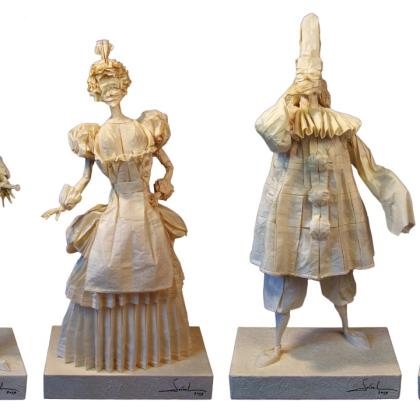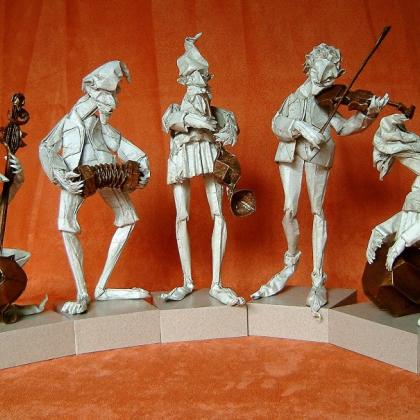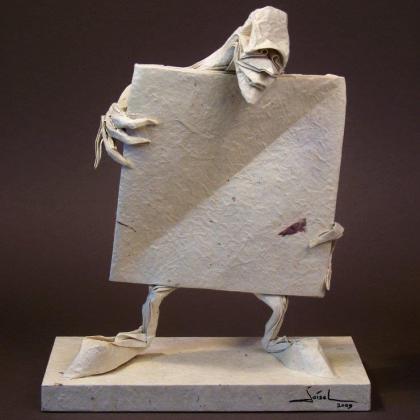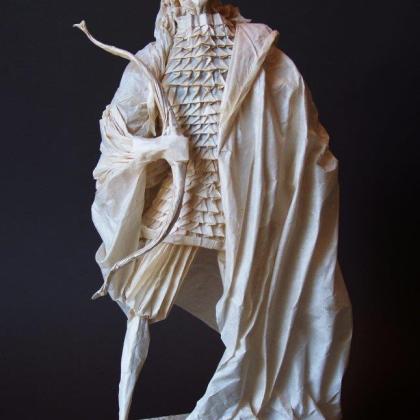Primary tabs
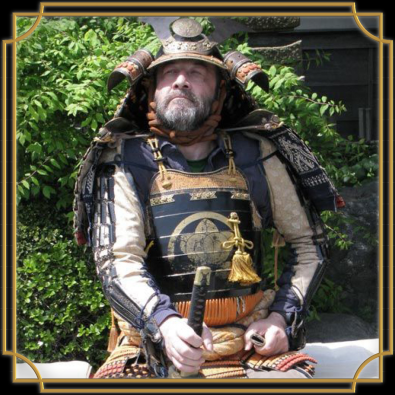
Eric Joisel
France
Summary
Éric Joisel (15 November 1956 – 10 October 2010) was a French origamist, considered to be one of the grandmasters of origami. He is credited with imbibing origami of liveness. According to his catalog of works (unpublished), he created more than 200 models, of which less than 20 designs were presented as diagrams. Joisel defined himself as an “origami sculptor”. In 1999, he was invited by origami grandmaster Akira Yoshizawa to his 88th Birthday Exposition at Matsura Ginza magazine in Tokyo, where only other four origami masters were allowed to show their models.
Life
Éric Joisel was born on 15 November 1956, in Paris, the youngest of a family of five children. After studying law and commerce, he started working as a designer and sculptor on wood, stone, and clay at 17 years old, then as a printer and, from time to time, as a clown. In his search for the best expression media in which to pour his mastership, he was a tireless worker, from five in the morning he could work fifteen hours in a row.
In 1983, after admiring Yoshizawa’s “Self-portrait” masterwork, artist Usataro Kimura introduced Joisel to origami. In 1984, while studying and learning techniques from origami masters, he started creating his own models with paper. Four years later, he saw his first exhibition at “Space Japon” in Paris. Devoted to teaching origami to the public and commanding various exhibitions, it was in 1992 when he decided to shift his work to origami full time and work for the MFPP for expositions, conventions, etc.
Though recognized already in France and America, where he attended some origami conventions, his wide international recognition started in 1997, at the British Origami Society convention where he met grandmaster Akira Yoshizawa.
In 1998, as director of the Paris Origami, he commanded an exposition at the Carrousel du Louvre where 20 of the most prominent origamists of the world, including Yoshizawa, were invited to show their work. Due to problems with sponsors and other issues, Joisel faces economic difficulties. Next year, Yoshizawa invites him to show his work in his 88th Birthday Exposition at Matsura Ginza magazine with other four origami masters.
After that, he was requested at conventions worldwide and he always tried to attend as much as possible. He always played with his French accent and his humor.
In 2008, he was diagnosed with lung cancer. In 2009, his economic situation was aggravated due to medical costs, and feared having to sell his home, which was prevented thanks to the sale of numerous sculptures to private collectors and institutions.
On the 10th of October 2010, Éric Joisel passed away at Argenteuil Hospital, with his family and close friends around him.
Work and Major Achievements
Although pioneered by Akira Yoshizawa, wet-folding (slightly dampening the paper before making a fold) was one technique where Éric Joisel excelled, becoming the best tool for an “origami sculptor”, as he defined himself. Due to his previous work as a sculptor, each fold of a design is different from the others, giving to each of them an unique character.
First Period (1989-1998): Animals
His first works (1989-1998) were animals using Box-Pleating (BP) and corrugation (1989 Snail, 1989 Hedgehog, 1997 Pangolin), using Fujimoto’s techniques (1996 Turtle), and more classic structures (1994 Rooster, 1995 Rat, 1998 Horse Head). His Pangolin was acclaimed for its wet-folding liveness.
Some years later, he revised some of his previous designs (1995 Bull became 2005 Winged Bull, and 1995 Rat #2 became 2007 “After the rat, the cat” sharing the same CP) and created two series: 2002 “Dogs” (Bulldog, Cocker Spaniel, Teckel, Great Dane, Sighthound and “Loyal Dog”) and 2003/2004 sea animals (2003 Fish, 2003 Starfish, 2004 Crab, 2004 Sea Urchin, c. 2004 Bivalve).
Joisel, with help during the folding process, created some life-size animals for his exhibitions at “Space Japon”: 1996 Rhinoceros, Pegasus and Hippopotamus.
Second Period (1996-2002): Masks & Busts
His second period (1996-2002) comprehends the creation of masks and busts. It’s clear that the “Self-portrait” by Yoshizawa and his wet-folding technique were the inspirational starting point, but Joisel was able to mold the paper to catch life-like expressions. The first masks were BP, but as he perfected his technique, he started to develop his own structures. The only mask series is 1998/1999 Greeks (The Orator, The Irony, Bellerophon, Aegeus, Melampus, Creon) to which 2000 Socrate could be adhered. Also, he created portraits of family, friends and prominent figures (2001 Nick Robinson, his brother Joseph, Modigliani…)
The busts, on the other hand, only present three different structures: one based on BP from 1997 of which only two models are known, the 1999 “Small Busts” oriented at creating facial expressions, and, in 2005, a more simple one which was used to create the booklet published in 2007 by the British Origami Society on this topic: “3D Masks & Busts”.
Third Period (2001-2003): Angle-BP
His third period (2001-2003), now with the human head developed, was to focus on the human body. For his first approach, he developed a new technique called “angle-BP”: while BP uses parallel lines to divide the paper in smaller squares, he divided the paper with radiating lines from the corners at different angles, which created extremely thin hands and feet as the main characteristic of these models. Remarkable sculptures are 2001 Nude Man (#6) and 2002 Black Man. In 2003, he started to add more complex clothes and the first “Lutins” (goblins) were created. Because of the required paper to shape the clothes, the facial features were mere creases into the model. This technique was abandoned in favor of the next design, but he created other two using a mixed version with BP: 2007 Sumo and 2009 Winged Fairy.
Fourth Period (2003-2006): Lutins
His fourth period (2003-2006) improved on the face, incorporating the needed paper to add detail. He added to his angle-BP “Lutin” (goblin) a new BP structure on top that allowed him to shape the face. This new “Lutin” was used to create his 2003 Orchestra #1 (“Fairies Orchestra”) and his 2009 Orchestra #4 (Goblin Orchestra).
In 2004, after modifying the bottom section of the “Lutin”, he created his Mermaid (which started as a variant of an Éric Vigier’s model), Penelope, Goblin Box/Out of Geometry, and his famous Dwarf. This model would be mocked to add different clothing (jacket with pockets, tailcoat, panties ‘Henry III’ and toga), and used to create another three music bands (with the exception of the “pocket” one, which was never used): 2006 Orchestra #2 (“Big Origami Jazz Band”), 2008 Orchestra #3 and 2010 Orchestra #5 (“Spanish Orchestra”).
In the same year of 2004, Joisel created his “Self-Made Man”, a celebrated model of a dwarf-alike being folding himself from a squared paper sheet, which he said jokingly was a self-portrait.
Fifth Period (2006-2010): Humans
His fifth period (2006-2010) marks his zenith in the search of the human body. With the technique for faces completely developed in his music bands, he turns to a complete BP structure his “Lutin”, allowing him to create more complex garments for more human-like models. The first ones were a couple from the “Commedia dell’Arte”: 2006 Pagliaccio and 2006 Columbine.
In 2007, he started a new series (“Barbarians”) with the model “Warrior with Sword”, which, the next year, would be transformed into “Aragorn” for a new celebrated series “The Community of the Ring”, later renamed to “The Lord of the Rings” as new models were created. In 2008, he added Gimli, Legolas, Gandalf, and Goblin (do not confound this work with his “Lutin”, which in English is also a “goblin”); and in 2009, Balrog (2009 Gargoyle composition re-worked as a balrog with a two-part sword), and The Old King (probably representing King Théoden of Edoras, being a variant design from Aragorn).
He was also creating stand-alone sculptures such as 2008 Don Quixote, 2008 Violiniste (human), 2008 Viking of the Crane (a later variant was renamed as 2009 Boromir and included in the “The Lord of the Rings” series), 2009 Mongol Warrior, and 2009 The King’s Hunter (which included a dog from his 2002 Dog series).
In 2009, he started the “The 7 Deadly Sins” series. Of the projected 7 sculptures, he only completed 4 of them in 2009, by finishing order: “Le Capitaine” (Pride), Columbine (Lust), Pagliaccio (Sloth), and Harlequin (Wrath). He left noted the last missing three characters: “Il Dottore” (The Doctor, probably “Gluttony”), Pantaleone (probably “Greed”), and “a young woman” (probably “Envy”).
In 2010, he started to design Sancho Panza (companion of 2008 Don Quixote) but was never finished. His last “new” sculptures were Corrida and Gloin; being “The Viking of the Crane” nº 2 from his “Barbarian” series, his last major work folded three months before his passing.
Corrida is a composition of quite motley sculptures: on an albero-color circle (to represent the bullfighters’ arena) and with a “burladero” (wooden wall safe to protect from the bull’s attacks), there is his realistic 2008 Bull, a squarish BP 2010 Bullfighter, and a crimp 2010 Picador (on horse).
Gloin was the first and only sculpture of a planned new series dedicated to “The Hobbit”.
This article was written by Franz Rogar. | Portrait image by Makoto Yamaguchi.
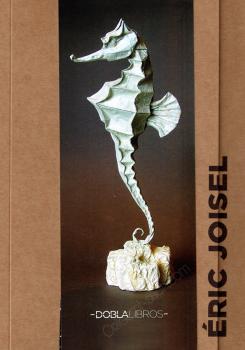 La magia del Papel - Hippocampe
By: EricJoisel
La magia del Papel - Hippocampe
By: EricJoisel
 La magia del Papel - Homme
By: EricJoisel
La magia del Papel - Homme
By: EricJoisel
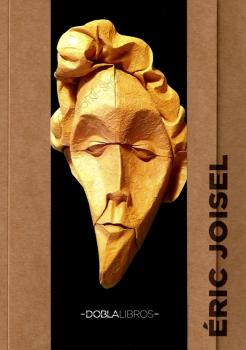 La magia del Papel - mask
By: EricJoisel
La magia del Papel - mask
By: EricJoisel
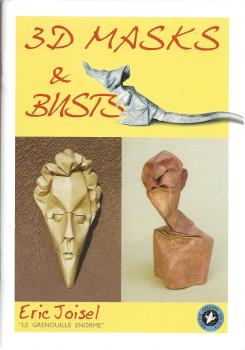 3D Masks & Busts
By: EricJoisel
3D Masks & Busts
By: EricJoisel
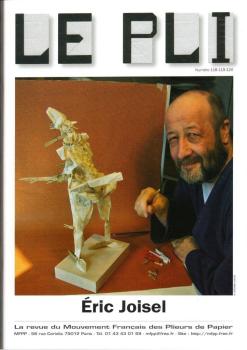 MFPP magazine "Le Pli" - special issue
By: EricJoisel
MFPP magazine "Le Pli" - special issue
By: EricJoisel
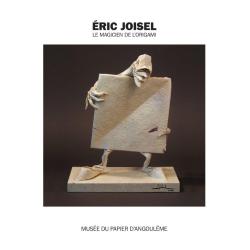 Exhibition catalog, "Musée du Papier"
By: EricJoisel
Exhibition catalog, "Musée du Papier"
By: EricJoisel
